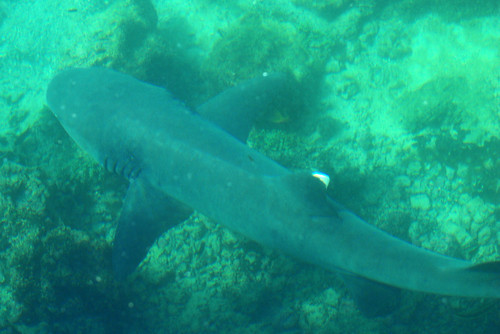slimming swim suits Galapagos Islands-703 swimsuit pictures
slimming swim suits A Whitetip Shark of the coast of Isabella Whitetip Shark The whitetip reef shark, Triaenodon obesus, is a species of requiem shark, family Carcharhinidae, and the only member of its genus. A small shark usually not exceeding 1.6 m (5.2 ft) in length, this species is easily recognizable by its slender body and short but broad head, as well as tubular skin flaps beside the nostrils, oval eyes with vertical pupils, and white-tipped dorsal and caudal fins. One of the most common sharks found on Indo-Pacific coral reefs, the whitetip reef shark occurs as far west as South Africa and as far east as Central America. It is typically found on or near the bottom in clear water, at a depth of 8â€"40 m (26â€"130 ft). During the day, whitetip reef sharks spend much of their time resting inside caves. Unlike other requiem sharks, which rely on ram ventilation and must constantly swim to breathe, this shark can pump water over its gills and lie still on the bottom. At night, whitetip reef sharks emerge to hunt bony fishes, crustaceans, and octopus in groups, their elongate bodies allowing them to force their way into crevices and holes to extract hidden prey. Individual whitetip reef sharks may stay within a particular area of the reef for months to years, time and again returning to the same shelter. This species is viviparous, in which the developing embryos sustained by a placental connection to their mother. One of the few sharks in which mating has been observed in the wild, receptive female whitetip reef sharks are followed by prospective males, who attempt to grasp her pectoral fin and maneuver the two of them into positions suitable for copulation. Females give birth to 1â€"6 pups every other year, after a gestation period of 10â€"13 months. Whitetip reef sharks are rarely aggressive towards humans, though they may investigate swimmers closely. However, spear fishers are at risk of being bitten by one attempting to steal their catch. This species is caught for food, though there are reports of ciguatera poisoning resulting from its consumption. The International Union for Conservation of Nature (IUCN) has assessed the whitetip reef shark as Near Threatened, noting that its numbers are dwindling due to increasing levels of unregulated fishing activity across its range. The slow reproductive rate and limited habitat preferences of this species renders its populations vulnerable to over-exploitation. The whitetip reef shark is distributed widely across the entire Indo-Pacific region. In the Indian Ocean, it occurs from northern KwaZulu-Natal, South Africa to the Red Sea and the Indian subcontinent, including Madagascar, Mauritius, the Comoros, the Aldabra Group, the Seychelles, Sri Lanka, and the Chagos Archipelago. In the western and central Pacific, it is occurs from off southern China, Taiwan, and the Ryukyu Islands, to the Philippines, Southeast Asia, and Indonesia, to northern Australia, and is also found around numerous islands in Melanesia, Micronesia, and Polynesia, as far as Hawaii to the north and the Pitcairn Islands to the southeast. In the eastern Pacific, it occurs from Costa Rica to Panama, and off the Galápagos Islands. Associated almost exclusively with coral reef habitats, whitetip reef sharks are most often encountered around coral heads and ledges with high vertical relief, and additionally over sandy flats, in lagoons, and near drop-offs to deeper water. They prefer very clear water and rarely swim far from the bottom. This species is most common at a depth of 8â€"40 m (26â€"130 ft). On occasion they may enter water less than a meter deep. A relatively small species, few whitetip reef sharks are longer than 1.6 m (5.2 ft). The whitetip reef shark has a slim body and a short, broad head. The snout is flattened and blunt. With its slender, lithe body, the whitetip reef shark specializes in wriggling into narrow crevices and holes in the reef and extracting prey inaccessible to other reef sharks. Alternately, it is rather clumsy when attempting to take food suspended in open water. This species feeds mainly on bony fishes, including eels, squirrelfishes, snappers, damselfishes, parrotfishes, surgeonfishes, triggerfishes, and goatfishes, as well as octopus, spiny lobsters, and crabs. The whitetip reef shark is highly responsive to the olfactory, acoustic, and electrical cues given off by potential prey, while its visual system is attuned more to movement and/or contrast than to object details. It is especially sensitive to natural and artificial low-frequency sounds in the 25â€"100 Hz range, which evoke struggling fish. Whitetip reef sharks hunt primarily at night, when many fishes are asleep and easily taken. After dusk, groups of sharks methodically scour the reef, often breaking off pieces of coral in their vigorous pursuit of prey. Multiple sharks may target the same prey item, covering every exit route from a particular coral head. Each shark hunts for itself and in competition with the others in its group. Unlike blacktip reef sharks and grey reef sharks, whitetip reef sharks do not become more excited when feeding in groups and are unlikely to be stirred into a feeding frenzy. Despite their nocturnal habits, whitetip reef sharks will hunt opportunistically in daytime. Off Borneo, this species gathers around reef drop-offs to feed on food brought up by the rising current. Off Hawaii, they follow Hawaiian monk seals (Monachus schauinslandi) and attempt to steal their catches. A whitetip reef shark can survive for six weeks without food. Fearless and curious, whitetip reef sharks may approach swimmers closely but are seldom aggressive unless provoked. However, these sharks readily attempt, and quite boldly, to steal catches from spear fishers, which have resulted in several people being bitten in the process. In some places, local whitetip reef sharks have learned to associate the sound of a speargun discharge or a boat dropping anchor with food and respond within seconds. As of 2008, the International Shark Attack File lists two provoked and three unprovoked attacks to this species. Whitetip reef sharks are well-suited to ecotourism diving, and with conditioning they can be hand-fed by divers. In Hawaiian mythology, the fidelity (i.e. \"loyalty\") of whitetip reef sharks to certain areas of the reef for years at a time may have inspired belief in Ê»aumÄkua, the spirits of family ancestors that take animal form and protect their descendants. Isabella Shaped like a sea horse, Isabela is the largest of the the islands in the Galapagos, more than 4 times larger than Santa Cruz the next largest. Isabela is 80 miles (100 km) in length and though it is remarkably beautiful it is not one of the most visited islands in the chain. Its visitor sites are far apart making them accessible only to faster boats or those with longer itineraries. One of the youngest islands, Isabela is located on the western edge of the archipelago near the Galapagos hot spot. At approximately 1 million years old, the island was formed by the merger of 6 shield volcanoes - Alcedo, Cerro Azul, Darwin, Ecuador, Sierra Negra and Wolf. Five of the six volcanoes are still active (the exception is Ecuador) making it one of the most volcanically active places on earth. Visitors cruising past Elizabeth Bay on the west coast can see evidence of this activity in the fumaroles rising from Volcan Chico on Sierra Negra. Two of Isabela\'s volcanoes lie directly on the equator - Ecuador and Volcan Wolf. Volcan Wolf is the youngest of Isabela\'s volcanoes and at 5,600ft (1707 m) the highest point in the Galapagos. Isabela is known for its geology, providing visitors with excellent examples of the geologic occurrences that have created the Galapagos Islands including uplifts at Urbina Bay and the Bolivar Channel, Tuft cones at Tagus Cove, and Pulmace on Alcedo. Isabela is also interesting for its flora and fauna. The young island does not follow the vegetation zones of the other islands. The relatively new lava fields and surrounding soils have not developed the sufficient nutrients required to support the varied life zones found on other islands. Another obvious difference occurs on Volcan Wolf and Cerro Azul, these volcanoes loft above the cloud cover and are arid on top. Isabela\'s rich animal, bird, and marine life is beyond compare. Isabela is home to more wild tortoises than all the other islands. Isabela\'s large size and notable topography created barriers for the slow moving tortoises; apparently the creatures were unable to cross lava flows and other obstacles, causing several different sub-species of tortoise to develop. Today tortoises roam free in the calderas of Alcedo, Wolf, Cerro Azul, Darwin and Sierra Negra. Alcedo Tortoises spend most of their life wallowing in the mud at the volcano crater. The mud offers moisture, insulation and protects their exposed flesh from mosquitoes, ticks and other insects. The giant tortoises have a mediocre heat control system requiring them to seek the coolness of the mud during the heat of the day and the extra insulation during the cool of the night. On the west coast of Isabela the nutrient rich Cromwell Current upwelling creating a feeding ground for fish, whales, dolphin and birds. These waters have long been known as the best place to see whales in the Galapagos. Some 16 species of whales have been identified in the area including humpbacks, sperms, sei, minkes and orcas. During the 19th century whalers hunted in these waters until the giant creatures were near extinction. The steep cliffs of Tagus Cove bare the names of many of the whaling ships and whalers which hunted in these waters. Birders will be delighted with the offerings of Isabela. Galapagos Penguins and flightless cormorants also feed from the Cromwell Current upwelling. These endemic birds nest along the coast of Isabela and neighboring Fernandina. The mangrove finch, Galapagos Hawk, brown pelican, pink flamingo and blue heron are among the birds who make their home on Isabela. A colorful part to any tour located on the western shore of Isabela, Punta Moreno is often the first or last stopping point on the island (depending on the direction the boat is heading). Punta Moreno is a place where the forces of the Galapagos have joined to create a work of art. The tour starts with a panga ride along the beautiful rocky shores where Galapagos penguins and shore birds are frequently seen. After a dry landing the path traverses through jagged black lava rock. As the swirling black lava flow gave way to form craters, crystal tide pools formed-some surrounded by mangroves. This is a magnet for small blue lagoons, pink flamingos, blue herons, and Bahama pintail ducks. Brown pelican can be seen nesting in the green leaves of the mangroves. You can walk to the edge of the lava to look straight down on these pools including the occasional green sea turtle, white-tipped shark and puffer fish. This idyllic setting has suffered from the presence of introduced species. Feral dogs in the area are known to attack sea Lions and marine iguanas. Galapagos Islands The Galápagos Islands (official name: Archipiélago de Colón; other Spanish names: Islas de Colón or Islas Galápagos) are an archipelago of volcanic islands distributed around the equator in the Pacific Ocean, some 900 km west of Ecuador. It is a UNESCO World Heritage site: wildlife is its most notable feature. Because of the only very recent arrival of man the majority of the wildlife has no fear of humans and will allow visitors to walk right up them, often having to step over Iguanas or Sea Lions.The Galápagos islands and its surrounding waters are part of a province, a national park, and a biological marine reserve. The principal language on the islands is Spanish. The islands have a population of around 40,000, which is a 40-fold expansion in 50 years. The islands are geologically young and famed for their vast number of endemic species, which were studied by Charles Darwin during the voyage of the Beagle. His observations and collections contributed to the inception of Darwin\'s theory of evolution by natural selection.






